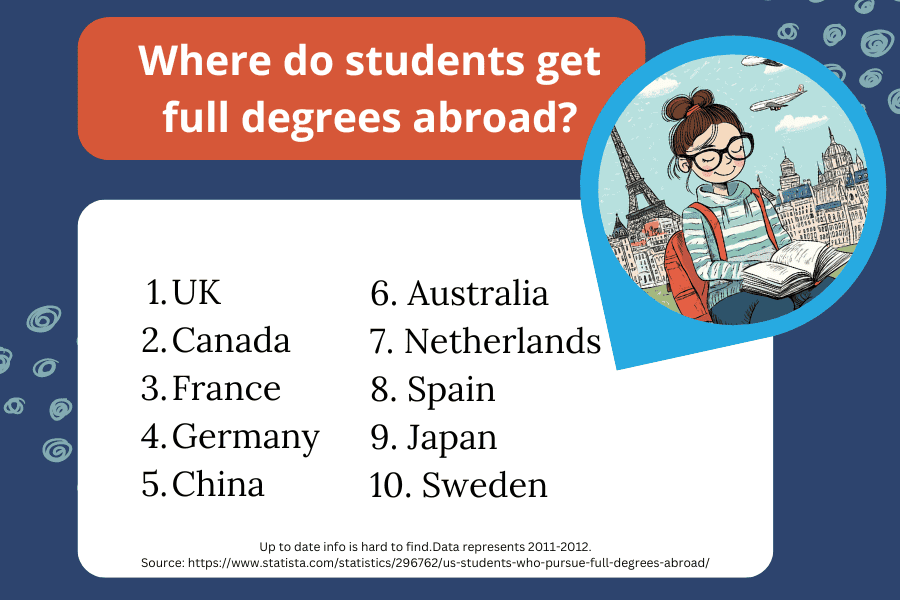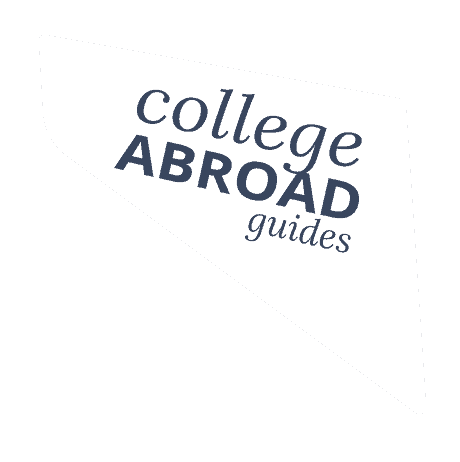Are You Wondering "Where Should I Get a Degree Abroad?"

No worries! We have 2 great ways to start your personalized list of fab universities outside the United States.
If you have a good idea of your preferred program, costs, and location, use our ultimate school finder to filter according to your preferences.
If you don’t, scroll down and take our quiz!
1. Use the School Finder
Our School Finder is a filterable map for students who want to explore where they can find their favorite major, narrowing their search by some common criteria.
Want to get the most out of it? Use partial word snippets for your desired Program of Study like “bio” to include both “biology” and “biomedial engineering”.
The Ultimate School Finder
Choose options or leave some blank to find the best of the top 255 universities with English-taught degrees. Click the map markers for a school's grades.
```
Program of Study
Total Tuition
Continent
Country
Avoid places with
Other Significant Factors
No idea where you want to get a degree abroad?
2. Take the Quiz!
Take the Personality-Based Quiz
Where are Most Students Studying Abroad?

It’s actually pretty hard to figure out where students directly apply to attend college abroad.
That’s because there’s no US government visa to leave — students are issued visas by their destination countries. Governments only know who’s gone based on re-entry passport scans and questioning. When applying directly to undergraduate programs, internationals tend to head to more English-speaking countries and places where they might try for a visa post-graduation.
Where do students like to study for just a year or even just the summer? They’re more likely to head for sunny European climates (and honestly, that seems like a decent idea).
Winners in both categories? Plenty of students are heading to the UK, France, Spain, and Australia.
Does this Map/Quiz Offer Every University in the World?
No.
It starts with 255 global universities with:
- English-taught degrees
- Academic rankings in the global top 1500
- 5% or greater international students
It eliminates:
- Universities in countries the US State Department warns you not to go to (but you can still check them out)
- Universities with missing data that we couldn’t source manually
- Universities in countries that criminalize LGBTQ students (but you can still check them out)
What’s left?
Just your own personalized criteria. And there’s no one who can answer the question, “Where should I study abroad?” quite like yourself.
English Speaking Country vs. English-Taught Program?
When you’re outside an English-speaking country, a higher number of programs means a larger cohort of potential friends who speak your language and the likelihood of more institutional experience with and support for international students.
Within English-speaking countries, the number of programs offered by a university matters much less. After all, most countries offer highly specialized degrees without gen-ed classes, and transferring to a different program is typically more difficult than in the states. Students who apply will likely stay in their programs until graduation.
What Majors are Available for Degrees Abroad in English?
You can likely find your favorite program in a lot of different places, but that’s not universal! In fact, put “photo” into our school finder and find the photographers of the world are pretty constrained as far as international degree options.
Every country has their specialties. Luckily, those vary a lot. Here are the majors most offered in the English-taught programs of each country.
Fun Facts About Our Top English-Taught Programs
Here’s what our 255 universities offer:
- 10,961 individual programs of study
- The most common programs? There are 143 psychology degrees, 132 computer science degrees, and 121 economics degrees.
- 39 countries
- An average total tuition (in USD, for the whole degree) of $69,287 (that’s not even $3,000 more than a single year at Columbia!)
Whether you’re hoping for a summer of fun or 4 years of study outside your home country, we can help you narrow your search to the criteria that are important to you and help you decide.
Sources
Race Equity Score: US News’ perception-based global survey
LGBTQ+-friendliness Score: Global Acceptance Index from UCLA, survey-based
Abortion on demand: Center for Reproductive Rights
Acceptance of foreigners: Gallup poll of anti-immigrant sentiment. We don’t feel great about this category’s data set yet. After all, it doesn’t include the “feel” of attending a university with high anti-Americanism where a job visa is technically available after graduation, but it impossible to achieve from a practical perspective. It doesn’t take into account political movements to strip more students from belonging. Take it as a starting point.
Low and high international student populations: Sourced manually from each university. Low = less than 15%. High = more than 25%.
Very high and “lower” academic standards: Percentile of the Times ranking only (which is not the same as the College Abroad Guide academic grades, which include the number of English-taught degrees and other foreigner-friendly factors). The schools included in these 255 total universities are already all in the top 2000 globally and do not include lower-ranked schools to start with. “Lower” standards here are average to high standards globally.
Highest costs: Tuition + Local cost of living index and rent prices in the locale, multiple sources depending on country.
Unhappiest countries: National happiness index, from Gallup world poll
Program of study: Sourced individually from each university 2024. Foundation year and top-up programs were eliminated, leaving stand-alone undergraduate degrees only. Universities use different names for similar programs. Please use alternate spellings, partial-match strings of letters, etc. for the most complete search.


